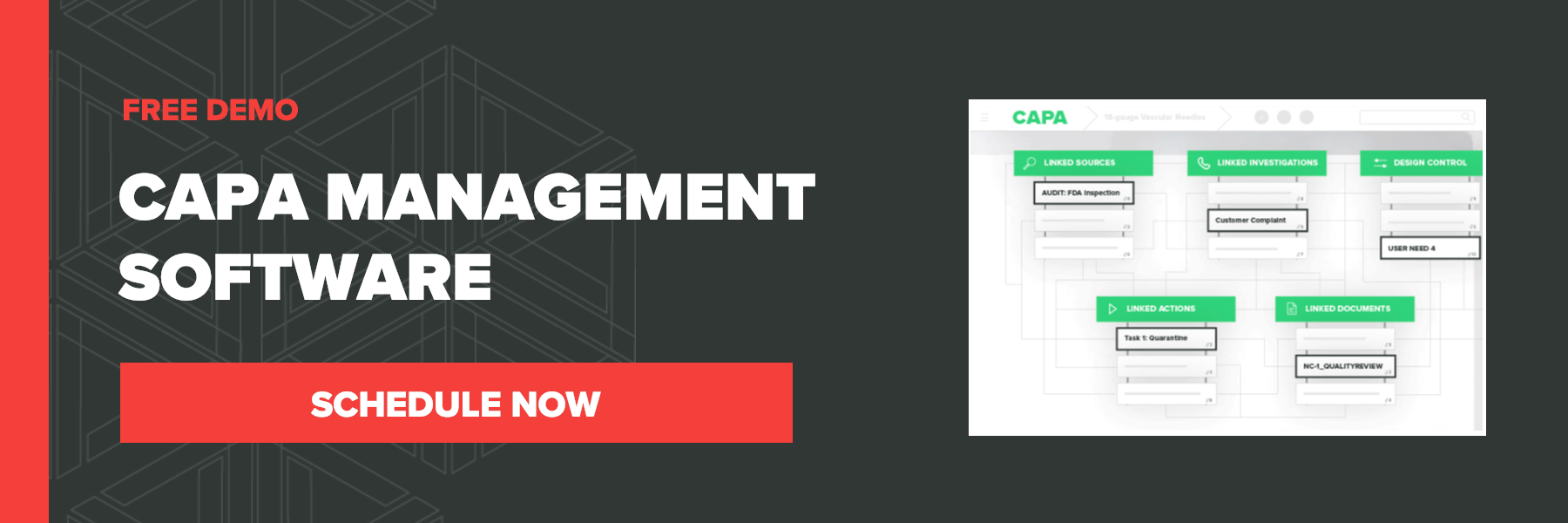CAPA: When to Take Corrective Action or Preventive Action?

How many of you can confidently initiate a CAPA and know exactly how and what to do and the process you should follow?
We’ve written about a few different issues to do with CAPA lately, largely because it tends to be an area that is still full of questions with a bit of confusion around the process and terminologies used.As you probably know, CAPA itself is an acronym for Corrective Action and Preventive Action. One of the things that companies need to be aware of is what exactly those things mean and when to use them:
Corrective Action
To begin with a quick refresh, you’re going to use a CAPA process to prevent and correct issues identified in your company, but not every issue warrants a CAPA.
If you have an issue that proves to be repetitive and systemic or it is something that is quite severe, that is when CAPA comes into play. Otherwise, you would just use other procedures within your quality system to manage the issue; for example, for your complaints procedure or change management.
So, let’s say you’ve found a series of non-conformances. You’ve discovered that you have a systemic issue and that you need to enact your CAPA procedure. Corrective action is what you might see as the quick, reactionary measures you take as a result.
The purpose of corrective action is to correct and contain any issues that you’ve identified. You could be trying any number of means to ensure that the incident doesn’t happen again or can’t spread any further.
For example, serious actions might include halting the manufacturing process until you’ve got to the bottom of the issue or putting products into quarantine rather than allowing them to go out to customers and end-users.
The corrective action is going to occur when you’ve had feedback from one of your quality data sources to show that you have an issue for CAPA.
Here’s another example; let’s imagine that your source for identifying a CAPA issue was an internal audit. Perhaps you’ve identified a non-conformance within manufacturing that appears to be happening regularly. A corrective action might be to immediately require your manufacturing staff to undergo extra training to help stop the issue from happening again (this could be a corrective and a preventive action).
An extreme corrective action would be to issue a recall of the product involved. A product recall is its own "beast" with many nuances and decision points that warrants its own discussion, so we won’t go into it in detail here. However, you should be familiar with and have procedures for addressing potential product recalls. Review FDA 21 CFR Part 806 for more details.
As you can probably tell, corrective action can be a bit “knee jerk” at times and might not even be a permanent solution to the issue. To say it another way, taking corrective action is very much about reacting to a situation that has already occurred.
Preventive Action
When you go into CAPA, there tends to be a greater emphasis on corrective actions rather than preventive.
People always seem to be fighting fires and taking a reactive stance. A good analogy is in your health care; for example, maybe you develop high blood pressure and are put on medications to lower it.
There are risk factors to high blood pressure that are known prior to the condition ever appearing. If someone knows they need to lose a few pounds ahead of ending up with high blood pressure, a good preventive action is to lose that weight. Going on the medication is the reactive, corrective action.
This is essentially the difference between corrective action and preventive action; preventive is proactive. It seeks to monitor and prevent issues before they become a problem.
Imagine you have a non-conformance and find an issue with product not meeting your specification, while that product is still under your control (at your manufacturing facility). A preventive action might be to look at inspecting more components or parts, or perhaps even inspecting more regularly. You want to be thorough with your product and inspection criteria before it becomes a problem. A good process implies that you have the necessary checks and balances in place to identify issues before your products leave the facility and therefore, before things like complaints or recalls become necessary.
For example, if you’ve had an issue with product A, have you checked products B and C as well? That issue might show up at some point for them too, especially if it is process-related, so be proactive.
If you found people weren’t following a procedure because they didn’t have adequate training, this might cause issues across multiple products or areas of the business. This is where that training is both corrective and preventive.
Here are some common preventive actions:
- Installing “alarms” into your process. This might be monitoring of statistics or process control charts.
- Audits or reviews of suppliers.
- Review of non-conformances in similar companies or products. How might the lessons learned there apply to your business? Perform regular risk analyses (such as Failure Modes Effects Analysis - FMEA) to uncover possibly hazards.
- Any preventative maintenance or calibration programs that ensure your equipment functions uniformly.
- Regular review of processes or controls to spot any potential issues that could drift into the area of a non-conformance.
- Establish comprehensive training programs with regular performance reviews to ensure employee performance standards are kept up.
- Have planning in place for hazards, disaster recovery, or any unexpected situations so that your company is prepared.
Be Proactive In CAPA Process
The overall aim is to design and develop quality systems that are leading indicators of any issues rather than lagging after the fact. Build in processes that help prevent issues from happening in the first place, then monitor and review those processes regularly.
Medical device companies that have a difficult time with compliance tend to be those who are reactive rather than proactive. Often, compliance activities become checkbox items that they “have” to do because they’re expecting an audit or inspection.
If this is the case, your company is missing the point. Regular monitoring and reviewing of processes can help you provide better, safer devices, which should always be the end goal. Monitoring or auditing should be treated as opportunities to learn and improve where possible.
Remember, the FDA won’t be sending you a warning letter just because you have a CAPA, they’ll do so because you didn’t document or follow good processes to deal with it.
Final Thoughts
Which sits more easily with your company? Reactive measures when issues arise or taking a proactive stance to catch things before they become an issue?
There tends to be a lot of “fire fighting” and focus given to corrective actions for non-conformances and less attention given to the proactive, preventive measures. Our feeling is that it tends to be the companies who strive to be proactive and catch possible issues before they become non-conformances who have a smoother path with getting their products to market and with dealing with regulatory bodies.
It might sound like a lot of work putting in checks and alarms, but doing that work upfront can save you from costly or time consuming corrective actions later on.
Still using a manual or paper-based approach to manage your quality processes such as CAPA's mentioned above? Click here to learn more about how Greenlight Guru's modern eQMS software platform exclusively for medical device companies is helping device makers all over the globe in more than 50 countries get safer products to market faster with less risk while ensuring regulatory compliance.
Jon Speer is a medical device expert with over 20 years of industry experience. Jon knows the best medical device companies in the world use quality as an accelerator. That's why he created Greenlight Guru to help companies move beyond compliance to True Quality.









